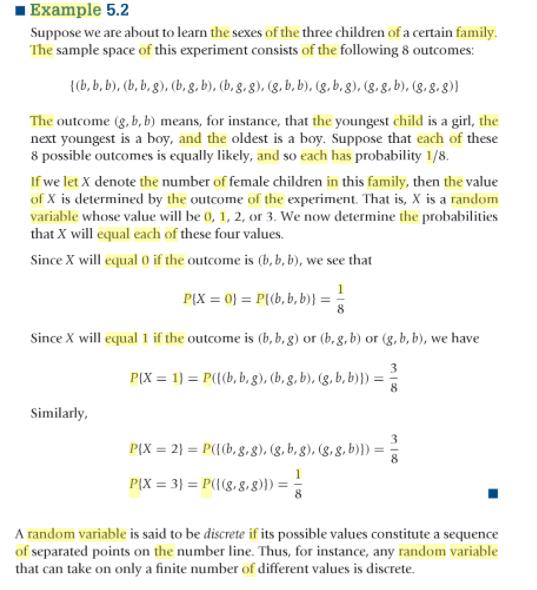Answered step by step
Verified Expert Solution
Question
1 Approved Answer
In Example 5.2, let the random variable Y equal 1 if the family has at least one child of each sex, and let it equal
In Example 5.2, let the random variable Y equal 1 if the family has at least one child of each sex, and let it equal 0 otherwise. Find P{Y = 0}


Example 5.2 Suppose we are about to learn the sexes of the three children of a certain family. The sample space of this experiment consists of the following 8 outcomes: {(b, b, b), (b, b.g), (b.g. b), (b, g.g), (g.b, b), (g.b.g), (8.8. b), (8.8.8)) The outcome (g, b, b) means, for instance, that the youngest child is a girl, the next youngest is a boy, and the oldest is a boy. Suppose that each of these 8 possible outcomes is equally likely, and so each has probability 1/8. If we let X denote the number of female children in this family, then the value of X is determined by the outcome of the experiment. That is, X is a random variable whose value will be 0, 1, 2, or 3. We now determine the probabilities that X will equal each of these four values. Since X will equal 0 if the outcome is (b, b, b), we see that 1 P{X = 0) = P((b, b, b)} : Since X will equal 1 if the outcome is (b, b, g) or (b, g, b) or (g, b, b), we have 3 PIX = 1) = P((b, b, g), (b, g. b), (g, b, b)}): Similarly, PIX = 2} = P((b, g.8), (g. b,g), (g,8.b)}) PIX = 3} = P(((8,8.g)): A random variable is said to be discrete if its possible values constitute a sequence of separated points on the number line. Thus, for instance, any random variable that can take on only a finite number of different values is discrete.
Step by Step Solution
★★★★★
3.45 Rating (148 Votes )
There are 3 Steps involved in it
Step: 1
Buestion there arp too Lin ods 4u fa...
Get Instant Access to Expert-Tailored Solutions
See step-by-step solutions with expert insights and AI powered tools for academic success
Step: 2

Step: 3

Ace Your Homework with AI
Get the answers you need in no time with our AI-driven, step-by-step assistance
Get Started


